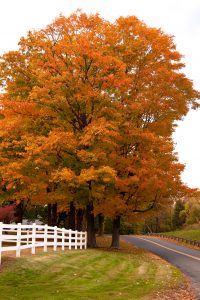
If you want to add value and beauty to your DFW landscape, it’s tough to beat an shade tree. As a bonus, DFW shade trees can attract a variety of wildlife to your yard, from butterflies to hummingbirds to squirrels. Great shade trees include Oaks, Maples, Ash, and Elms. Which to choose depends on how fast you want shade and your growing conditions. Maples grow much faster than Oaks.
You also need to consider the variety of tree you buy. There are Maples with small leaves that don’t get very big. You can buy Oaks that are columnar, with very little spread that also won’t make a good shade tree. You should also consider how close the tree will be to your house and if you are OK with the tree making a mess on your lawn on top of your house. An oak tree shading your house can be a great dream until you have gutters full of acorns.
Live oak. If you don’t mind acorns too much, a live oak tree has enormous appeal. They typically grow to about 40 feet tall and 75 feet wide. And they can live to 500 years. Note: They are not a good match with small city lots, as the root systems can cause serious problems.
Shumard red oak. In the right conditions, this tree can grow to more than 100 feet and a wide canopy. It also offers other nice features, such as the green leaves can turn a beautiful red in the winter.
Chinquapin oak (Quercus muehlenbergii ) Native to north central and east Texas. It grows to 70 feet with a three foot diameter trunk and 45 to 50 feet wide, and a rounded canopy. It does well in limestone soil. It has dark green glossy leaves that resemble Chestnut leaves or Sawtooth Oak. The wood of a Chinquapin oak is strong and can hold up in high winds and ice.
Bur oak. Bur oak is a fast growing shade tree and features huge leaves and a corresponding size of acorns—although the number is relatively small. At maturity, this Texas native grows to 50-60 feet. It’s also resistant to many diseases that plague many trees. You can read more about Bur Oak on our Native trees page.
Cedar elm. Unlike most elms, cedar elms are terrific trees. This north Texas native can grow to 50-60 feet and 40-50 feet wide. Its biggest drawback is it’s susceptibility to disease, which includes Dutch elm disease, mildew, and mistletoe. It tolerates both drought and wet conditions.
Redbud tree. While maturing at 20-30 feet tall, the redbud tree isn’t a monstrous shade tree, but with its flashy pinkish flowers, it adds brilliant color to your landscape. Additionally, it’s a low-maintenance tree. Its biggest drawback is that it’s susceptible to disease and often dies within 20 years. Eventually, this small tree will shade a one-story house. This could shade your house while you are waiting for a slow grower like a Live Oak to grow big enough to shade your house for the next 200 years.
Pecan. Our state tree is a slow-growing tree, maturing at 12 years, and takes about that long to start producing fruit. It grows to 100 feet tall and 50 feet wide. Most of the pecan tree diseases are related more to the fruit and not the tree, which means you will probably need to occasionally spray to preserve the pecans. Not only is the pecan tasty to humans, they are a vital food source. Deer, raccoons, squirrels and even some birds rely on pecan trees for sustenance.
DFW Shade Trees Summary
The good news with regards to shade trees, north Texas homeowners have a wide variety, with an array of features that would work for almost any yard. Just do your homework, take lots of pictures, and talk to experts.
